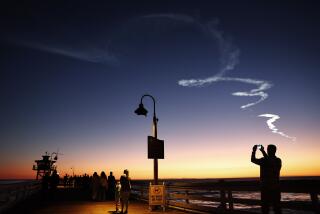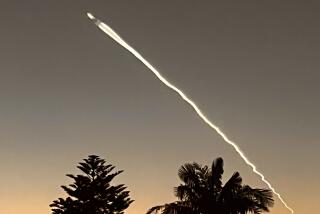Atlantis Completes Secret Spy Satellite Mission
- Share via
EDWARDS AIR FORCE BASE — In a rare afternoon landing, the shuttle orbiter Atlantis glided into a perfect touchdown here at 3:36 p.m. Tuesday, capping an apparently flawless four-day, nine-hour mission in which five military astronauts launched a massive spy satellite and performed other classified activities.
Descending on a more northerly route than usual, Navy Cmdr. Robert L. (Hoot) Gibson eased Atlantis onto Runway 17 on the dry bed of Rogers Lake after a perfect re-entry.
Touching down to scattered applause from small knots of Edwards workers, Gibson used the newly overhauled brakes on Atlantis to decelerate sharply, rolling to a stop short of the 7,000 to 13,000 feet usually required. During the roll down the runway, Gibson tested the shuttle’s new nose wheel steering system before rolling to a stop.
The five-man crew exited the shuttle at 4:29 p.m. The astronauts then inspected the shuttle’s tiles, which appeared badly pitted from re-entry. One NASA spokesman Ralph Jackson said the tiles were “the worst I’ve ever seen them.”
“We have just finished a very exciting . . . successful mission. We had a wonderfully good time,” Gibson told reporters just before the crew boarded NASA jets for Houston four hours after landing.
It was only the second afternoon landing at Edwards. The orbiters usually land shortly after dawn to take advantage of the absence of winds at that time. But Tuesday afternoon was crisp, clear and virtually windless, and Atlantis encountered no difficulties.
Because of Air Force-imposed secrecy, the public was not allowed onto the base to view the landing. Access was restricted to the news media and a few invited guests, including the astronauts’ families.
“It was a great flight, a super flight. It shows we can serve our (Department of Defense) customers as we have in the past,” said James C. Fletcher, National Aeronautics and Space Administration administrator.
The Atlantis flight, the 27th shuttle mission and the second since the January, 1986, explosion that destroyed the Challenger and took the lives of seven astronauts, got off to a spectacular beginning with a 6:31 a.m. PST launch Friday from Cape Canaveral, Fla. Once Atlantis reached orbit, however, NASA refused further public comment about the flight, citing its military nature.
Virtually the only official comment came Monday from Rear Adm. Richard Truly, who has been in charge of the shuttle program since the Challenger accident. He said, “Things are going super. The crew is happy and healthy. The orbiter has done real well. It’s been very clean.”
Although the cargo has never been officially revealed, most analysts agree that it is a $500-million spy satellite, called LaCrosse, that is designed to spy on the Soviet Union. LaCrosse features massive solar panels and a football-field-sized radar antenna that will provide highly detailed images of the ground in all weather conditions. The satellite will travel as far north as Moscow and provide coverage of 80% of the Soviet countryside.
Unofficial sources said Air Force Col. Richard M. Mullane successfully deployed the satellite Saturday morning. But amateur astronomers have reported observing a bright object in orbit beside Atlantis as early as 4 p.m. Friday. That object presumably was the satellite.
The Atlantis crew also reportedly tested hand-held viewing devices shaped like binoculars to observe military maneuvers on the ground. The test is designed to show that the orbiter can be used to monitor battles in the event of war.
Atlantis apparently flew in tandem with LaCrosse for most of the mission while ground controllers at Sunnyvale tested the satellite, then withdrew 40 miles before firing its rockets for re-entry at 2:29 p.m. Tuesday. The orbiter came to a stop 4 days, 9 hours, 6 minutes and 19 seconds after blastoff after 69 orbits totaling 1.7 million miles.
In addition to Gibson, 42 and Mullane, 43, the members of the Atlantis crew are Lt. Col. Guy S. Gardner, 39, and Lt. Col. Jerry L. Ross, 40, of the Air Force and Navy Cmdr. William M. Shepherd, 39.
The next shuttle mission is set for Feb. 18 when the orbiter Discovery is scheduled to carry a communications satellite into orbit. That mission suffered a setback last week, however, when a technician at Cape Canaveral stumbled and bumped into the rocket nozzle on the first stage of the booster designed to carry the satellite into its final orbit, cracking the nozzle badly.
That accident will delay testing of the booster from Dec. 10 until about Dec. 27, according to NASA spokesman George Diller, and technicians will probably have to work two shifts a day, seven days a week to maintain Discovery’s launch schedule.
More to Read
Sign up for Essential California
The most important California stories and recommendations in your inbox every morning.
You may occasionally receive promotional content from the Los Angeles Times.










